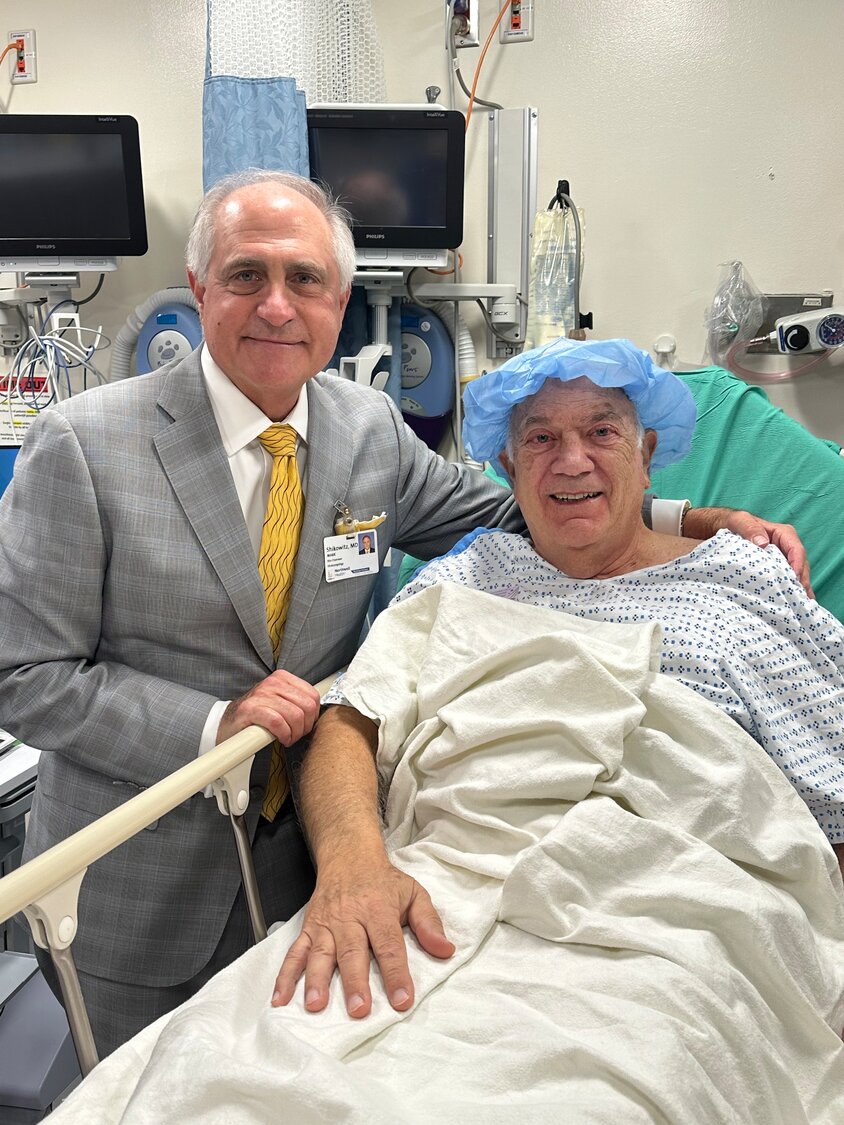Implant eradicates obstructive sleep apnea
Getting a good night’s sleep, finally
A small device roughly the size of a pacemaker is changing the lives of people suffering from moderate to severe obstructive sleep apnea.
The device, Inspire, which does not require a hose or mask — components in a CPAP machine — is battery operated, utilizing a neurostimulator implanted surgically under the skin in the upper right portion of a patient’s chest. Its sensor stimulates the tongue to contract and move forward, thereby opening the obstructed airway.
The Inspire device is activated by the patient using a remote control. Its degree of stimulation is gradual, also controlled by the patient.
Dr. Harley Greenberg, a pulmonologist and sleep medicine physician at Glen Cove Hospital, said he’s seen much success among his patients who had Inspire implanted.
“Some people find the sensation a little strange, but they get used to it,” he said. “When you turn it on, it has a start delay so it stays off when the patient is falling asleep. Then it turns on.”
Patients experience a month’s recovery after the surgery. Then they go to their doctor’s office where the device is programed to determine the degree of electrical stimulation needed to advance the tongue forward and open the airway.
“Then the patient is sent home with the device, and they have complete control of it,” Greenberg said. “We retest with sleep studies to see how effective it has been in treating their sleep apnea.”
Sleep apnea, which causes snoring and restless sleep, can be more than annoying. Untreated, it can cause cardiovascular disease, is linked to diabetes, hypertension, high blood pressure, kidney problems and increases the risk for heart attack four and a half times greater than a person who smokes cigarettes. Sleep apnea is also linked to strokes, loss of short-term memory and daytime sleepiness.
Glen Cove Hospital surgeon Dr. Mark Shikowitz, who specializes in otolaryngology, said Inspire is better than any other procedure available for people with obstructive sleep apnea.
“Our success rate is 92 percent,” he said. “With a CPAP machine, which uses air pressure to push through the obstructed area, compliance is 50 percent. With this device people improve or are cured.”
Stephen Tarnofsky, of Merrick, used a CPAP machine to treat his sleep apnea for roughly eight years. He experienced a variety of problems.
“I was on blood thinners and found mucus in the morning with blood in it,” Tarnofsky said. “I’d also wake up very dry and sometimes have to drink water in the middle of the night. And keeping the machine clean was also a problem.”
Most people with sleep apnea sleep with their mouth open, he said. For him using the mask that covered his mouth and nose was never comfortable. At one time he was able to sleep seven hours. With a CPAP machine Tarnofsky was only clocking in five hours a night because the machine would wake him up.
Although traditionally people use a CPAP machine to treat sleep apnea, Shikowitz has used other techniques, some more invasive than others. Sometimes simply having large tonsils removed will cure sleep apnea. In other instances, surgery is performed where the soft palate is trimmed or tightened to expand a patient’s airway. Years ago, he said, he performed a tracheotomy, which was lifesaving.
“If someone has a tongue that falls back, we’ve done procedures where we’ve either pulled the jaw forward or actually sutured the back of the tongue forward to underneath the jaw,” Shikowitz said. “There are many different combinations of procedures depending on the individual patient and the individual’s problem that is causing the airway obstruction.”
A CPAP machine mask which is hooked up to a compressor where air is forced into one’s airways can be uncomfortable, especially if a patient has a physical obstruction, like a thick tongue or deviated septum. Additionally, people who are claustrophobic may find the machine difficult to tolerate.
Although Inspire, which was approved by the Food and Drug Administration in 2014, has helped many, there are stringent requirements that must be met before becoming eligible.
“You have to have a sleep study, a drug-induced endoscopy, you can be fat but not too fat, and the sleep apnea can be bad but not too bad,” Shikowitz said. “You also have to fail other more standard therapies like CPAP. Insurance companies won’t approve the surgery if you can sleep with a CPAP mask. And to qualify, your airway has to collapse in only the front to back direction.”
While the requirements are numerous, Shikowitz said many people meet all of the parameters.
Doctors ask for his help as well. They won’t move forward with a surgery until the patient has their sleep apnea under control.
“People who do cardiac ablations (to treat heart arrhythmias) want us to fix the sleep apnea because they know there won’t be a high rate of success if the patient has sleep apnea,” Shikowitz explained.
Shikowitz says the surgery is well tolerated with very few side effects. Afterwards patients are given pain medication for four to five days while they heal with some people feeling 100 percent better in a few days, and others up to a week.
On Oct. 24 Tarnofsky became the 200th patient at Glen Cove Hospital to have the Inspire device implanted. It was activated on Nov. 30.
Tarnofsky said he’s doing fine.
“It pushes your tongue out but when you are asleep you don’t feel it,” he said. “The good thing is I don’t snore now. I really don’t see any downside to having it. I recommend people have it done.”
For further information on Inspire, call Shikowitz’s office at (516) 470-7550.







